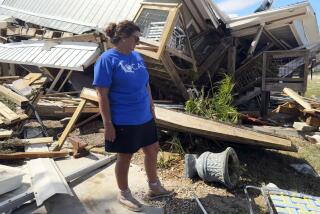Sandbaggers Battle Mighty River--and Pray for Luck : Flooding: In towns up and down the Mississippi, round-the-clock efforts focus on shoring up the levees.
- Share via
WAPELLO, Iowa — They lost the Wapello levee, and despite a punishing rain so dense that they could barely see in front of them at times, the sandbaggers of nearby Oakville knew that their saturated barrier was next.
For 48 hours an exhausted crew of 200 farmers, workers and Army reservists had done their best to keep floodwaters from cascading into these two towns wedged between the bloated Mississippi River and the Iowa River, newly roiled by three inches of rainfall.
Up and down the Mississippi and its tributaries, in scores of flood-threatened river towns, the levee watch goes on--a tense drama whose outcome depends on the earthen levees’ durability, the water’s power and, with a little bit of luck, the labors of volunteer sandbag crews.
The land north of Wapello was a lost cause Thursday afternoon. The flooding had already forced the evacuation of 500 residents and submerged 5,000 acres of farmland north of the town, high enough in some areas to submerge the first floors of farmhouses.
Oakville was still dry, but there were eight holes in the town’s levee against the Iowa River, each one a potential gash that could let the flood in.
“It’s a total loss for everybody if we lose the levee,” said Steve Metcalfe, the town’s volunteer fire chief. “We’re gonna need a lot of prayin’.”
Metcalfe had been out on the line Wednesday night, examining Oakville’s earthen dike for water boils, underground spurts that signal severe water pressure on the dam. All day long Thursday, farmers patrolled the levee on foot and on all-terrain vehicles, testing for soft spots and firming them up with sandbags.
The levee was so porous in some spots that the ground bounced like a trampoline as monitors walked on it.
“You know it’s bad when you hear it gurgling like a coffee pot,” Metcalfe said. “We’ve been getting too much of that.”
A line of water that suddenly becomes visible in an earthen levee indicates a hole. Clear water means no erosion, but a stream of dirty water means that a hole is widening and taking the earth with it--and had better be shored up before it bursts open.
If the Klaxon at the Oakville firehouse goes off, signaling that the levee has broken, it could prove ruinous for the town’s tiny commercial strip and many of the 450 residents who live nearby.
Most of Oakville’s houses have not been sandbagged. Many of the town’s women and children have gone to stay with relatives and friends out of harm’s way. The husbands and fathers who remain have been too busy sandbagging the levee and moving their possessions to worry about keeping the water away from their houses.
Protecting homes “is pretty much a lost cause,” said Ken Seitz, 29, a metal shop worker at a plant that makes spark plugs. He and his wife, Melissa, 28, had stopped for a drink at the White Elephant, one of the few businesses still open in downtown Oakville.
Nursing a Coke, Seitz said he and his wife have packed off their three children to stay with relatives. But they refuse to leave, convinced that the levee will hold.
“When the National Guard decides they’ve had enough and they got to go, everybody has to go,” Seitz said. “We’re just waiting to see what happens.”
If the water comes, he said, “it’ll be a sinking feeling. Then it’ll be real to me.”
The White Elephant has stayed open to serve sandbaggers, but its only remaining attraction is liquor. The bar’s jukebox, pool tables and pinball machines were all removed last Friday by a nervous rental agent.
“It was pretty quiet in there last night,” Metcalfe said. “You could practically hear people thinking. And you can imagine what they were thinking about.”
In Wapello, a town of 2,300 people, thoughts were even gloomier. Don and Karen Meeker, one of 16 families forced to evacuate after a flood wall gave way Wednesday night, spent much of the day after wondering what had become of their house.
Most of their furniture had been moved out to a friend’s home, but Don Meeker, 54, just had to take another look at the house. To get to it, he had to go by boat. He found the Iowa River four inches from his front door.
“I’m heartsick,” said Karen Meeker, 48. “You don’t eat, you don’t sleep, you just try and get enough courage to go and look at the house.” She stayed away when her husband went off to examine their home.
Wapello officials first learned at 11 p.m. Monday that their levee was about to give way. Lloyd Meyerholz, 50, a town levee commissioner, was one of several public officials who telephoned farmers whose land was in the path of the flood, warning them to evacuate.
When the levee broke, Meyerholz lost 500 acres of his own land. He had been able to move 110 head of cattle to a neighboring farm, but his soybean, corn and wheat crops are gone.
Meyerholz’s house remains dry only because it stands on high ground. He has had no more than three hours of sleep at a time over the past two days, spending much of his time near the town’s surviving levee.
When the sun finally broke through the rain clouds late Thursday afternoon, Meyerholz was still at his post, watching for water boils. He squinted into the sun and, for a passing moment, his gloom lifted.
“Isn’t it nice here?” he said. “It’s so peaceful and quiet.”
Then he turned back to the levee.
Shryer reported from Wapello and Braun reported from Chicago.
More to Read
Sign up for Essential California
The most important California stories and recommendations in your inbox every morning.
You may occasionally receive promotional content from the Los Angeles Times.









